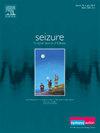Thalamic stereoelectroencephalography in pediatric patients: Clinical practice and considerations
IF 2.8
3区 医学
Q2 CLINICAL NEUROLOGY
引用次数: 0
Abstract
Objective
Neuromodulation of cortical and subcortical structures is integral to pediatric epilepsy surgery. Subcortical and thalamic targets for neuromodulation continue to evolve. This paper reports the practical considerations and outcomes of pediatric thalamic stereoelectroencephalography (sEEG) at a single institution.
Methods
A retrospective study involved 16 patients with drug-resistant epilepsy who underwent sEEG with thalamic nuclei sampling at Children’s National Hospital (CNH) from July 2023 to Aug 2024. Electrodes targeted thalamic nuclei, including the anterior nucleus of thalamus (ANT), centromedian (CM), and/or pulvinar (PUL). Two pediatric epileptologists reviewed sEEG recordings at enhanced sensitivity to identify thalamic spread patterns. The definitive procedure after sEEG and the outcomes were reported for those who proceeded to surgery with at least six months of follow-up.
Results
Sixteen subjects underwent sEEG with thalamic nuclei sampling. Thirty-five thalamic electrodes were implanted, and four patients had multisite thalamic nuclei sampling. Most seizures reviewed (84 %) had early thalamic involvement (<500 ms from seizure onset). A variety of early thalamic spread patterns were detected: spike wave, 30 % (n = 15/50); rhythmic slowing, 20 % (n = 10/50); and low voltage fast activity (LVFA), 16 % (n = 8/50). Among the fifteen patients exhibiting thalamic involvement, nine (60 %) demonstrated congruent ictal patterns originating from the neocortex, whereas 40 % exhibited discordant patterns. Furthermore, 60 % of patients (n = 9) exhibited consistent thalamic spread patterns, whereas 40 % demonstrated variable patterns across different nuclei within the same seizure or within the same nucleus across seizures. Eleven patients underwent surgery after the sEEG, and seizure outcomes of seven patients with a mean follow-up period of 7.9 months were reported. Only one patient experienced transient hemiparesis from an anterior insular hemorrhage.
Conclusion
Thalamic sEEG may serve as a valuable tool for selected patients with complex or extensive epileptic networks and may aid in the identification of neuromodulation targets when resection or ablation is not feasible.
儿科患者的丘脑立体脑电图:临床实践和考虑
目的神经调节皮层和皮层下结构是儿童癫痫手术不可或缺的一部分。神经调节的皮层下和丘脑靶点继续进化。本文报告了在单一机构进行儿童丘脑立体脑电图(sEEG)的实际考虑和结果。方法对2023年7月至2024年8月在国立儿童医院(CNH)行丘脑核取样sEEG治疗的16例耐药癫痫患者进行回顾性研究。电极瞄准丘脑核,包括丘脑前核(ANT)、中核(CM)和/或pulvinar (PUL)。两名儿童癫痫学家以更高的灵敏度审查了sEEG记录,以确定丘脑的扩散模式。随访至少6个月的患者报告了sEEG后的最终手术和结果。结果16例受试者接受了丘脑核取样的sEEG。植入35个丘脑电极,对4例患者进行多部位丘脑核取样。大多数癫痫发作(84%)有早期丘脑受累(距癫痫发作500毫秒)。检测到多种早期丘脑扩散模式:峰值波,30% (n = 15/50);节律性减慢,20% (n = 10/50);低电压快速活性(LVFA), 16% (n = 8/50)。在表现出丘脑受累的15名患者中,9名(60%)表现出源自新皮层的一致的tal模式,而40%表现出不一致的模式。此外,60%的患者(n = 9)表现出一致的丘脑扩散模式,而40%的患者在同一次发作中或在同一次发作中表现出不同核的不同模式。11例患者在sEEG后接受了手术,7例患者的癫痫发作结果平均随访时间为7.9个月。仅有1例患者因岛前部出血而出现短暂性偏瘫。结论丘脑sEEG可作为一种有价值的工具,用于选择具有复杂或广泛癫痫网络的患者,并可在切除或消融不可行的情况下帮助识别神经调节靶点。
本文章由计算机程序翻译,如有差异,请以英文原文为准。
求助全文
约1分钟内获得全文
求助全文
来源期刊

Seizure-European Journal of Epilepsy
医学-临床神经学
CiteScore
5.60
自引率
6.70%
发文量
231
审稿时长
34 days
期刊介绍:
Seizure - European Journal of Epilepsy is an international journal owned by Epilepsy Action (the largest member led epilepsy organisation in the UK). It provides a forum for papers on all topics related to epilepsy and seizure disorders.
 求助内容:
求助内容: 应助结果提醒方式:
应助结果提醒方式:


